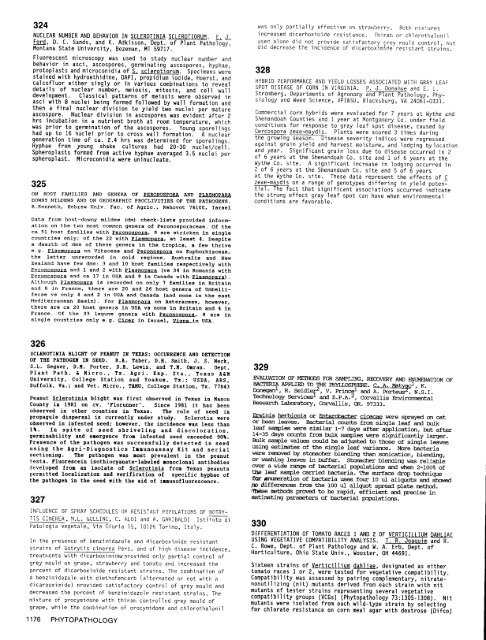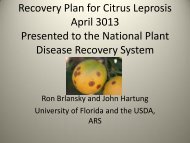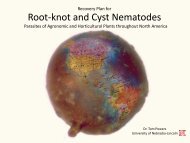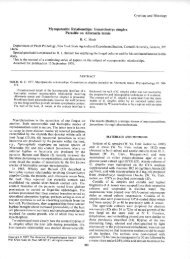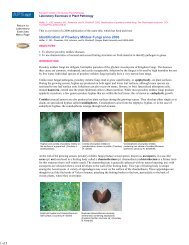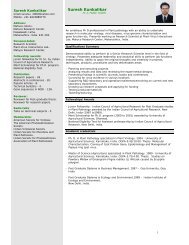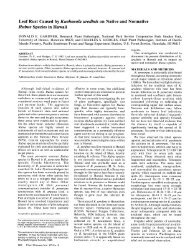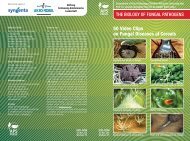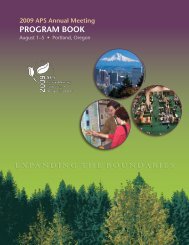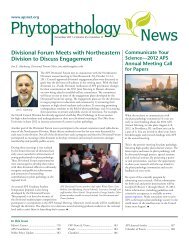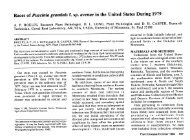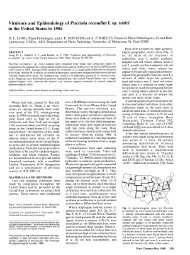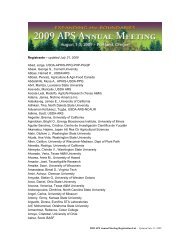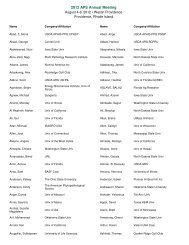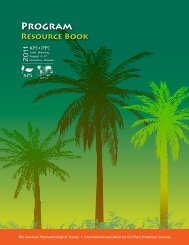view article - American Phytopathological Society
view article - American Phytopathological Society
view article - American Phytopathological Society
Create successful ePaper yourself
Turn your PDF publications into a flip-book with our unique Google optimized e-Paper software.
324<br />
NUCLEAR NUMBER AND BEHAVIOR IN SCLEROTINIA SCLEROTIORUM. E. J.<br />
Ford, D. C. Sands, and K. Adkisson, Dept. of Plant Pathology,<br />
Montana State University, Bozeman, MT 59717.<br />
was only partially effective on strawberry. Both mixtures<br />
increased dicarboximide resistance. Thiram or chlorothalonil<br />
useo alone did not provide satisfactory crey mould control hut<br />
did decrease the incidence of dicarboximide resistant strains.<br />
Fluorescent microscopy was used to study nuclear number and<br />
behavior in asci, ascospores, germinating ascospores, hyphae,<br />
protoplasts and microconidia of S. sclerotiorum. Specimens were<br />
stained with hydroethidine, DAPI, propidium iodide, Hoerst, and<br />
calcofluor either singly or in various combinations to reveal<br />
details of nuclear number, meiosis, mitosis, and cell wall<br />
development. Classical patterns of meiosis were observed in<br />
asci with 8 nuclei being formed followed by wall formation and<br />
then a final nuclear division to yield two nuclei per mature<br />
ascospore. Nuclear division in ascospores was evident after 2<br />
hrs incubation in a nutrient broth at room temperature, which<br />
was prior to germination of the ascospores. Young sporelings<br />
had up to 16 nuclei prior to cross wall formation. A nuclear<br />
generation time of ca. 2.4 hrs was determined for sporelings.<br />
Hyphae from young shake cultures had 20-30 nuclei/cell,<br />
Spheroplasts formed from active hyphae averaged 3.5 nuclei per<br />
spheroplast. Microconidia were uninucleate.<br />
328<br />
HYBRID PERFORMANCE AND YIELD LOSSES ASSOCIATED WITH GRAY LEAF<br />
SPOT DISEASE OF CORN IN VIRGINIA. P. J. Donahue and E. L.<br />
Stromberg, Departments of Agronomy and Plant Pathology, Phy<br />
Strog, departments of Alant PA Phy-<br />
siology and Weed Science, VPI&SU, Blacksburg, VA 24061-0331.<br />
Commercial corn hybrids were evaluated for 7 years at Wythe and<br />
Shenandoah Counties and 1 year at Montgomery Co. under field<br />
conditions for response to gray leaf spot disease, caused by<br />
Cercospora zeae-maydis. Plants were scored 3 times during<br />
the growing season. Disease severity indices were regressed<br />
against grain yield and harvest moisture, and lodging by location<br />
and year. Significant grain loss due to disease occurred in 2<br />
of 6 years at the Shenandoah Co. site and 1 of 6 years at the<br />
Wythe Co. site. A significant increase in lodging occurred in<br />
325<br />
ON HOST FAMILIES AND GENERA OF PERONOSPORA AND PLASBMOPBA<br />
DOWNY MILDEWS AND ON GEOGRAPHIC PROCLIVITIES OF THE PATHOGENS.<br />
R.Kenneth, Hebrew Univ. Fac. of Agric., Rehovot 76100, Israel<br />
2 of 6 years at the Shenandoah Co. site and 5 of 6 years<br />
at the Wythe Co. site. These data represent the effects of C<br />
zeae-maydis<br />
tial.<br />
on a range of genotypes<br />
The<br />
differing in yield poten-<br />
fact that significant associations occurred indicate<br />
the strong effect gray leaf spot can have when environmental<br />
conditions are favorable.<br />
Data from host-downy mildew (dm) check-lists provided information<br />
on the two most common genera of Peronosporaceae. Of the<br />
ca 51 host families with Peronospora, 8 are stricken in single<br />
countries only; of the 22 with Plasmopara, at least 4. Despite<br />
a dearth of dms of these genera in the tropics, a few thrive<br />
e.g. Plasmopara on Vitaceae and Peronospora on Euphorbiaceae,<br />
the latter unrecorded in cold regions. Australia and New<br />
Zealand have few dms: 3 and 10 host families respectively with<br />
PeronosPora and 1 and 2 with Plasmopara (vs 34 in Romania with<br />
Persnoanora and ca 17 in USA and 9 in Canada with Plasmopara).<br />
Although Plasmopara is recorded on only 7 families in Britain<br />
and 8 in France, there are 20 and 26 host genera of Umbelliferae<br />
vs only 4 and 2 in USA and Canada (and none in the east<br />
Mediterranean Basin). For Plasmopara on Asteraceae, however,<br />
there are ca 20 host genera in USA vs none in Britain and 4 in<br />
France. Of the 33 legume genera with Peronosl.ora, 8 are in<br />
single countries only e.g. Cicer in Israel, yigna in USA.<br />
326<br />
SCLEROTINIA BLIGHT OF PEANUT IN TEXAS: OCCURRENCE AND DETECTION<br />
OF THE PATHOGEN IN SEED. R.A. Taber, D.H. Smith, J. S. Neck,<br />
S.L. Segner, D.M. Porter, D.H. Lewis, and T.M. Omran. Dept. 329<br />
Plant Path. & Micro., Unierity tatonandYokum Tx. Cllee Agri. Exp. Sta., T;; Texas SD, AS, A&M EVALU]ATION OF MEIHDSFOR SAMPIG, RIECOVERY<br />
University,<br />
AND<br />
College Station<br />
ENUMERATION<br />
and<br />
OF<br />
Yoakum, Tx.;-USDA, ARS, BAC IA APPLIED TO THE PHYLLOSPHERE. Q. A. MatyacI, K.<br />
Suffolk, Va.; and Vet. Micro., TAMIU, College Station, Tx. 77843 Donegan , R. Seidler 2 , V. Prince 1 and A. Porteus2. N.S.I.<br />
Peanut Sclerotinia blight was first observed in Texas in Mason Technology ServicesI and E.P.A.2, Corvallis Environ.ental<br />
County in 1981 on cv. 'Florunner'. Since 1981 it has been Research Laboratory, Corvallis, OR. 97333.<br />
observed in other counties in Texas. The role of seed in Erwini herbicola or Enterobacter cloacae were sprayed on oa<br />
propagule dispersal is currently under study. Sclerotia were orwin le a Bacteri ac te r oaca e le af a nd bulk<br />
observed in infested seed; however, the incidence was less than or bean leaves. Bacterial Counts from single leaf and bulk<br />
1%. In spite of seed shriveling and discoloration, leaf samples were similar 1-7 days after application, bit after<br />
germinability and emergence from infested seed exceeded 90%. 14-35 days Counts from bilk samples were significantly larger.<br />
Presence of the pathogen was successfully detected in seed Butlk sample values could be adjusted to those of mingle leaves<br />
using the Agri-Diagnostics Inmunoassay Kit and serial using estimates of the single leaf varianc. More bacteria<br />
sectioning. The pathogen was most prevalent in the peanut were remo~ved by stomacher blending than sonication, blending,<br />
testa. Fluorescein isothiocyanate-labeled monoclonal antibodies or washing leaves in biffer. Stomacher blendling was reliable<br />
developed from an isolate of Sclerotinia from Texas peanuts ovrawdrngofbceilppatnsndhn2-0%f<br />
permitted localization and verification of specific hyphae of t)he Leaf sample carried bacteria. The surface drop technique<br />
the pathogen in the seed with the aid of immunofluorescence, f~r enumerzation of bacteria uses four 10 ul aliquots and showed<br />
nO cifferene from the 100 ul aliquot spread plate method.<br />
,These methods proved to be rapid, efficient and precise in<br />
327 estimating parametera of bacterial populations.<br />
INFLUENCE OF SPRAY SCHEDULES O)N RESIST/GIT POPULATIONiS OF BOTRY-<br />
TIS CINEREA. M.L. GULLINC, C. ALDI and A. GARIBALDI Istituto di 330<br />
Patologia vegetale, Via Giuria 15, 10126 Torino, Italy.<br />
In the presence of benziinidazole and dicarboximide resistant<br />
strans cnera f Btryts Pes. nd f hih dseae inidece,<br />
treatm~ents with di carboximides provided only partial control of<br />
grey mould on grape, strawberry and tomato and increased the<br />
percent of dicarboximide resistant strains. The combination of<br />
a benzimidazole with diethofencarb (alternated or not with a<br />
dicaooxinie) dicaboxmid) stisactry<br />
atifactry povied<br />
oovied ontol<br />
ontol o<br />
f<br />
gry<br />
gry<br />
muldand<br />
muldand<br />
decreased the percent of benzimidazole resistant strains. The<br />
mixture of procysidone with thiran controlled grey mould of<br />
grape, while the combination of orocymidone and chlorothalonil<br />
DIFFERENTIATION OF TOMATO RACES 1 AND 2 OF VERTICILLIUM DAHLIAE<br />
USING VEGETATIVE COMPATIBILITY ANALYSIS. T. R. Joaauim and R.<br />
C. Rowe, Dept. of Plant Pathology and W. A. Erb, Dept. of<br />
HriutrOi tt nvWotr H461<br />
Sixteen strains of Verticillium dahliae, designated as either<br />
tomato races 1 or 2, were tested for vegetative compatibility.<br />
Compatibility was assessed by pairing complementary, nitrate-<br />
mutants<br />
nonutilizing<br />
of tester<br />
(nit)<br />
strains<br />
mutants<br />
representing<br />
derived from each<br />
several<br />
strain with<br />
vegetative<br />
nit<br />
compatibility groups (VCGs) (Phytopathology 73:1305-1308). Nit<br />
mutants were isolated from each wild-type strain by selecting<br />
for chlorate resistance on corn meal agar with dextrose (Difco)<br />
1176 PHYTOPATHOLOGY


